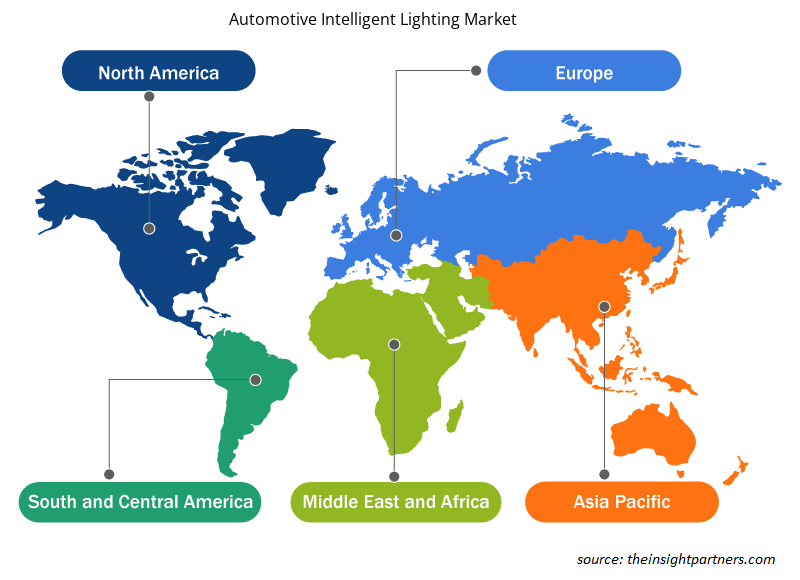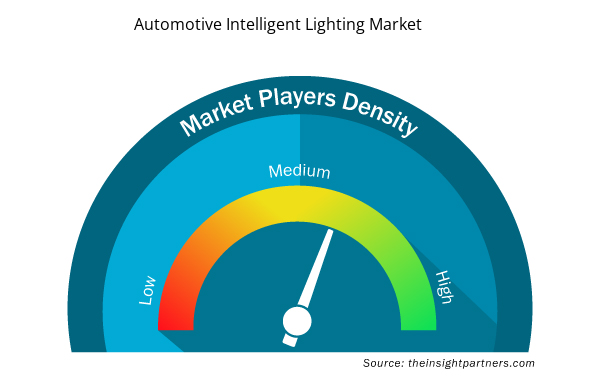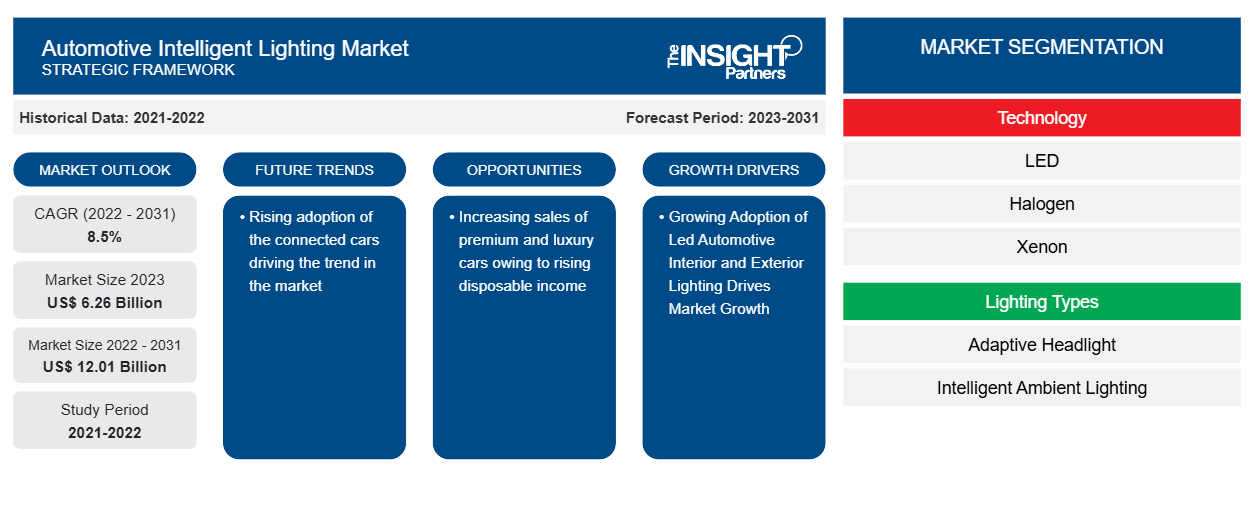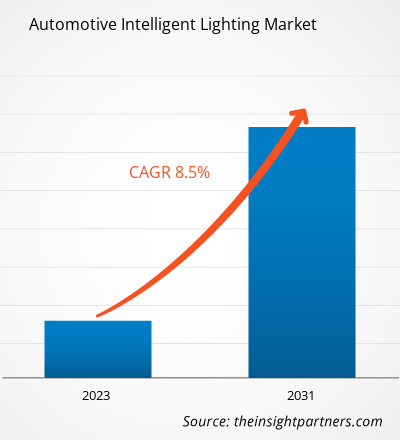من المتوقع أن يصل حجم سوق الإضاءة الذكية للسيارات إلى 12.01 مليار دولار أمريكي بحلول عام 2031 من 6.26 مليار دولار أمريكي في عام 2023. ومن المتوقع أن يسجل السوق معدل نمو سنوي مركب بنسبة 8.5٪ في الفترة 2022-2031. يتبنى مصنعو السيارات في جميع أنحاء العالم تقنية إضاءة LED في مركباتهم بوتيرة سريعة. يتكون سوق إضاءة السيارات من عدة أنواع من منتجات LED، مثل المصابيح الأمامية ومصابيح التركيز وغيرها. علاوة على ذلك، فإن التبني المتزايد لإضاءة LED للسيارات في سيارات الركاب يدفع نمو سوق الإضاءة الذكية للسيارات العالمية. على سبيل المثال، ساهمت إضاءة LED بنحو 70٪ من مصابيح المؤشر الداخلية وحوالي 25٪ من الإضاءة الخلفية لشاشة العدادات. حاليًا، في تطبيقات الإضاءة الذكية للسيارات يتم تركيب مصابيح التوقف الموجودة في وسط السيارة ومصابيح الفرامل والخلفية. سوق الإضاءة الذكية للسيارات مجزأة للغاية بسبب وجود العديد من اللاعبين الرئيسيين في السوق.
تحليل سوق الإضاءة الذكية للسيارات
إن انتشار المصابيح الأمامية الذكية LED للسيارات له أكبر حصة في عام 2023. ومن المتوقع أن يصل إلى حوالي 65٪ بحلول عام 2025 حيث تنمو مبيعات السيارات بوتيرة سريعة مع زيادة الطلب العالمي على السيارات المتصلة. تستخدم الإضاءة الذكية للسيارات العديد من التقنيات مثل شعاع القيادة التكيفي ونظام الإضاءة الأمامية التكيفي. تتوفر مصابيح السيارات الذكية الرقمية في السيارات الفاخرة ونماذج المركبات الفاخرة والفاخرة. على سبيل المثال، وجود الإضاءة الذكية للسيارات في العديد من الموديلات، أودي مع مصفوفة LED الذكية، ومرسيدس بنز، ووجود WEY مع مصباح أمامي ذكي LED بكسل. عامل سطوع الليزر أكبر بحوالي خمس مرات من مصادر الضوء الأخرى المتوفرة في السوق. لذلك، توفر المصابيح الأمامية بالليزر نطاقات شعاع أعلى لسائقي المركبات. يتراوح نطاق شعاع مصباح الليزر النموذجي فوق 500 متر. تعد BMW i8 وBMW 7 سلسلة سيارات الركاب الأخرى التي تتميز بمصابيح أمامية مدمجة بالليزر.
نظرة عامة على سوق الإضاءة الذكية للسيارات
مع التبني السريع لحلول الإضاءة الذكية للسيارات، تقدم شركات تصنيع السيارات أنظمة ذكية محسّنة. تقدم شركات تصنيع السيارات ميزات أمان نشطة متقدمة مثل الإضاءة التكيفية والإضاءة الداخلية المعدلة باستخدام الإضاءة المحيطة الذكية للمستهلكين. التبني المستمر للتقنيات المتقدمة، مثل الإضاءة المحيطة الذكية والتكيفية، لتوسيع نطاق واسع من التطبيقات، مثل المؤشرات التكيفية والمصابيح الخلفية التكيفية وأضواء وقوف السيارات التكيفية، من بين أمور أخرى. العامل الرئيسي الدافع لنمو الإضاءة الذكية للسيارات هو التبني المتزايد للإضاءة التكيفية مع المعايير الحكومية الصارمة لتوفير الأمان للمركبات في مختلف البلدان والطلب المتزايد على المركبات الفاخرة والمريحة من الدرجة الممتازة.
قم بتخصيص هذا التقرير ليناسب متطلباتك
ستحصل على تخصيص لأي تقرير - مجانًا - بما في ذلك أجزاء من هذا التقرير، أو تحليل على مستوى الدولة، وحزمة بيانات Excel، بالإضافة إلى الاستفادة من العروض والخصومات الرائعة للشركات الناشئة والجامعات
- احصل على أهم اتجاهات السوق الرئيسية لهذا التقرير.ستتضمن هذه العينة المجانية تحليلاً للبيانات، بدءًا من اتجاهات السوق وحتى التقديرات والتوقعات.
محركات وفرص سوق الإضاءة الذكية للسيارات
الاعتماد المتزايد على الإضاءة الداخلية والخارجية للسيارات باستخدام تقنية LED يدفع نمو السوق
تتمتع المصابيح الخلفية والأمامية بأكبر حصة في سوق الإضاءة الذكية للسيارات بشكل عام. يتطلع مصنعو السيارات إلى دمج مكونات السيارات خفيفة الوزن لتعزيز كفاءة الوقود ومتطلبات السلامة وتحسين أداء السيارة. تُستخدم الإضاءة الذكية LED على نطاق واسع في السيارات لتحسين متطلبات السلامة وتعزيز الرؤية وفقًا لمتطلبات العميل. مصابيح LED أكثر برودة وأصغر حجمًا وتستهلك طاقة أقل مقارنة بمصابيح السيارات القياسية الأخرى. تُستخدم مصابيح LED للسيارات على نطاق واسع في المصابيح الأمامية التي تساعد السائقين على الحصول على رؤية أفضل للطرق ورؤية أفضل للطريق وبالتالي تحسين كفاءة الوقود.
زيادة مبيعات السيارات الفاخرة والفاخرة بسبب ارتفاع الدخل المتاح
وفي البلدان المتقدمة حيث يتمتع المستهلكون بدخل هائل، لوحظ أنه مع ارتفاع عدد السكان الذين يستخدمون المركبات، تختلف تفضيلات المستهلكين لشراء سيارات الركاب . ونتيجة لهذا، لم تعد التكلفة وكفاءة الوقود المعيارين الأساسيين لشراء هذه السيارات؛ بل أصبحت عمليات الشراء تعتمد بشكل أكبر على الراحة والرفاهية التي توفرها هذه السيارات. وعلاوة على ذلك، أصبح المستهلكون يقيمون بشكل متزايد أنظمة الإضاءة وبيئة العمل في السيارة أثناء اتخاذهم للخيارات.
تقرير تحليل تجزئة سوق الإضاءة الذكية للسيارات
إن القطاعات الرئيسية التي ساهمت في اشتقاق تحليل سوق الإضاءة الذكية للسيارات هي التكنولوجيا وأنواع الإضاءة وأنواع المركبات.
- استنادًا إلى التكنولوجيا، ينقسم سوق الإضاءة الذكية للسيارات العالمية إلى LED وHalogen وXenon وLaser. ومن بين هذه التقنيات، تتمتع تقنية LED بالحصة الأكبر في عام 2023، وذلك بسبب زيادة اعتمادها في سيارات الركاب.
- وفقًا لأنواع الإضاءة، يتم تقسيم سوق الإضاءة الذكية للسيارات العالمية إلى المصابيح الأمامية المتكيفة والإضاءة المحيطة الذكية.
- اعتمادًا على نوع السيارة، يتم تقسيم السوق إلى سيارات ركاب ومركبات تجارية.
تحليل حصة سوق الإضاءة الذكية للسيارات حسب المنطقة الجغرافية
ينقسم النطاق الجغرافي لتقرير سوق الإضاءة الذكية للسيارات بشكل أساسي إلى خمس مناطق: أمريكا الشمالية وأوروبا وآسيا والمحيط الهادئ والشرق الأوسط وأفريقيا وأمريكا الجنوبية.
تمتلك منطقة آسيا والمحيط الهادئ أكبر حصة في عام 2023. ويرجع ذلك إلى زيادة مبيعات سيارات الركاب في جميع أنحاء الهند والصين واليابان. في الصين، ينمو سوق الإضاءة الذكية للسيارات بأعلى معدل نمو سنوي مركب يبلغ حوالي 8.6٪ خلال الفترة المتوقعة 2019 و 2025. لا يزال معدل اختراق LED منخفضًا في سوق آسيا والمحيط الهادئ وينمو بوتيرة سريعة خلال الفترة المتوقعة. هذه هي العديد من شركات الإضاءة الذكية للسيارات الصينية مثل Guangzhou Stanley Electric Co.، Ltd. و Shanghai Koito Automotive Lamp Co.، Ltd. و Changchun و Hella و Faway Automotive Lighting Co.، Ltd. و Valeo Lighting Hubei Technology Center Co.، Ltd. وقد شكلت هذه الشركات الرئيسية حوالي 60٪ من حصة السوق في سوق الإضاءة الذكية للسيارات.
رؤى إقليمية حول سوق الإضاءة الذكية للسيارات
لقد قام المحللون في Insight Partners بشرح الاتجاهات والعوامل الإقليمية المؤثرة على سوق الإضاءة الذكية للسيارات طوال فترة التوقعات بشكل شامل. يناقش هذا القسم أيضًا قطاعات سوق الإضاءة الذكية للسيارات والجغرافيا في جميع أنحاء أمريكا الشمالية وأوروبا ومنطقة آسيا والمحيط الهادئ والشرق الأوسط وأفريقيا وأمريكا الجنوبية والوسطى.

- احصل على البيانات الإقليمية المحددة لسوق الإضاءة الذكية للسيارات
نطاق تقرير سوق الإضاءة الذكية للسيارات
| سمة التقرير | تفاصيل |
|---|---|
| حجم السوق في عام 2023 | 6.26 مليار دولار أمريكي |
| حجم السوق بحلول عام 2031 | 12.01 مليار دولار أمريكي |
| معدل النمو السنوي المركب العالمي (2022 - 2031) | 8.5% |
| البيانات التاريخية | 2021-2022 |
| فترة التنبؤ | 2023-2031 |
| القطاعات المغطاة | حسب التكنولوجيا
|
| المناطق والدول المغطاة | أمريكا الشمالية
|
| قادة السوق وملفات تعريف الشركات الرئيسية |
|
Market Players Density: Understanding Its Impact on Business Dynamics
The Automotive Intelligent Lighting Market market is growing rapidly, driven by increasing end-user demand due to factors such as evolving consumer preferences, technological advancements, and greater awareness of the product's benefits. As demand rises, businesses are expanding their offerings, innovating to meet consumer needs, and capitalizing on emerging trends, which further fuels market growth.
Market players density refers to the distribution of firms or companies operating within a particular market or industry. It indicates how many competitors (market players) are present in a given market space relative to its size or total market value.
Major Companies operating in the Automotive Intelligent Lighting Market are:
- Automotive Lighting LLC
- Hella GmbH & Co. KGaA
- Koito Manufacturing Co.,Ltd.
- Lumileds Holding BV
- Osram Continental GmbH
- SL Corporation
Disclaimer: The companies listed above are not ranked in any particular order.

- Get the Automotive Intelligent Lighting Market top key players overview
Automotive Intelligent Lighting Market News and Recent Developments
The automotive intelligent lighting market is evaluated by gathering qualitative and quantitative data post primary and secondary research, which includes important corporate publications, association data, and databases. The following is a list of developments in the market for automotive intelligent lighting market and strategies:
- In July 2023, Marelli collaborated with OSRAM to launch an innovative automotive front lighting h-Digi micro-LED module. This intelligent digital lighting solution is built with the intelligent multipixel LED that enables fully adaptive, dynamic headlight operation and image projection. This made available for a wider range of vehicles. (Source: Marelli, Press Release/Company Website/Newsletter)
Automotive Intelligent Lighting Market Report Coverage and Deliverables
The “Automotive Intelligent Lighting Market Size and Forecast (2021–2031)” report provides a detailed analysis of the market covering below areas:
- Market size and forecast at global, regional, and country levels for all the key market segments covered under the scope
- Market dynamics such as drivers, restraints, and key opportunities
- Key future trends
- Detailed PEST analysis
- Global and regional market analysis covering key market trends, major players, regulations, and recent market developments
- Industry landscape and competition analysis covering market concentration, heat map analysis, prominent players, and recent developments
- Detailed company profiles with SWOT analysis
- التحليل التاريخي (سنتان)، السنة الأساسية، التوقعات (7 سنوات) مع معدل النمو السنوي المركب
- تحليل PEST و SWOT
- حجم السوق والقيمة / الحجم - عالميًا وإقليميًا وقطريًا
- الصناعة والمنافسة
- مجموعة بيانات Excel



Report Coverage
Revenue forecast, Company Analysis, Industry landscape, Growth factors, and Trends

Segment Covered
This text is related
to segments covered.

Regional Scope
North America, Europe, Asia Pacific, Middle East & Africa, South & Central America

Country Scope
This text is related
to country scope.
Trends and growth analysis reports related to Automotive and Transportation : READ MORE..
The Insight Partners performs research in 4 major stages: Data Collection & Secondary Research, Primary Research, Data Analysis and Data Triangulation & Final Review.
- Data Collection and Secondary Research:
As a market research and consulting firm operating from a decade, we have published and advised several client across the globe. First step for any study will start with an assessment of currently available data and insights from existing reports. Further, historical and current market information is collected from Investor Presentations, Annual Reports, SEC Filings, etc., and other information related to company’s performance and market positioning are gathered from Paid Databases (Factiva, Hoovers, and Reuters) and various other publications available in public domain.
Several associations trade associates, technical forums, institutes, societies and organization are accessed to gain technical as well as market related insights through their publications such as research papers, blogs and press releases related to the studies are referred to get cues about the market. Further, white papers, journals, magazines, and other news articles published in last 3 years are scrutinized and analyzed to understand the current market trends.
- Primary Research:
The primarily interview analysis comprise of data obtained from industry participants interview and answers to survey questions gathered by in-house primary team.
For primary research, interviews are conducted with industry experts/CEOs/Marketing Managers/VPs/Subject Matter Experts from both demand and supply side to get a 360-degree view of the market. The primary team conducts several interviews based on the complexity of the markets to understand the various market trends and dynamics which makes research more credible and precise.
A typical research interview fulfils the following functions:
- Provides first-hand information on the market size, market trends, growth trends, competitive landscape, and outlook
- Validates and strengthens in-house secondary research findings
- Develops the analysis team’s expertise and market understanding
Primary research involves email interactions and telephone interviews for each market, category, segment, and sub-segment across geographies. The participants who typically take part in such a process include, but are not limited to:
- Industry participants: VPs, business development managers, market intelligence managers and national sales managers
- Outside experts: Valuation experts, research analysts and key opinion leaders specializing in the electronics and semiconductor industry.
Below is the breakup of our primary respondents by company, designation, and region:

Once we receive the confirmation from primary research sources or primary respondents, we finalize the base year market estimation and forecast the data as per the macroeconomic and microeconomic factors assessed during data collection.
- Data Analysis:
Once data is validated through both secondary as well as primary respondents, we finalize the market estimations by hypothesis formulation and factor analysis at regional and country level.
- Macro-Economic Factor Analysis:
We analyse macroeconomic indicators such the gross domestic product (GDP), increase in the demand for goods and services across industries, technological advancement, regional economic growth, governmental policies, the influence of COVID-19, PEST analysis, and other aspects. This analysis aids in setting benchmarks for various nations/regions and approximating market splits. Additionally, the general trend of the aforementioned components aid in determining the market's development possibilities.
- Country Level Data:
Various factors that are especially aligned to the country are taken into account to determine the market size for a certain area and country, including the presence of vendors, such as headquarters and offices, the country's GDP, demand patterns, and industry growth. To comprehend the market dynamics for the nation, a number of growth variables, inhibitors, application areas, and current market trends are researched. The aforementioned elements aid in determining the country's overall market's growth potential.
- Company Profile:
The “Table of Contents” is formulated by listing and analyzing more than 25 - 30 companies operating in the market ecosystem across geographies. However, we profile only 10 companies as a standard practice in our syndicate reports. These 10 companies comprise leading, emerging, and regional players. Nonetheless, our analysis is not restricted to the 10 listed companies, we also analyze other companies present in the market to develop a holistic view and understand the prevailing trends. The “Company Profiles” section in the report covers key facts, business description, products & services, financial information, SWOT analysis, and key developments. The financial information presented is extracted from the annual reports and official documents of the publicly listed companies. Upon collecting the information for the sections of respective companies, we verify them via various primary sources and then compile the data in respective company profiles. The company level information helps us in deriving the base number as well as in forecasting the market size.
- Developing Base Number:
Aggregation of sales statistics (2020-2022) and macro-economic factor, and other secondary and primary research insights are utilized to arrive at base number and related market shares for 2022. The data gaps are identified in this step and relevant market data is analyzed, collected from paid primary interviews or databases. On finalizing the base year market size, forecasts are developed on the basis of macro-economic, industry and market growth factors and company level analysis.
- Data Triangulation and Final Review:
The market findings and base year market size calculations are validated from supply as well as demand side. Demand side validations are based on macro-economic factor analysis and benchmarks for respective regions and countries. In case of supply side validations, revenues of major companies are estimated (in case not available) based on industry benchmark, approximate number of employees, product portfolio, and primary interviews revenues are gathered. Further revenue from target product/service segment is assessed to avoid overshooting of market statistics. In case of heavy deviations between supply and demand side values, all thes steps are repeated to achieve synchronization.
We follow an iterative model, wherein we share our research findings with Subject Matter Experts (SME’s) and Key Opinion Leaders (KOLs) until consensus view of the market is not formulated – this model negates any drastic deviation in the opinions of experts. Only validated and universally acceptable research findings are quoted in our reports.
We have important check points that we use to validate our research findings – which we call – data triangulation, where we validate the information, we generate from secondary sources with primary interviews and then we re-validate with our internal data bases and Subject matter experts. This comprehensive model enables us to deliver high quality, reliable data in shortest possible time.


 احصل على عينة مجانية لهذا التقرير
احصل على عينة مجانية لهذا التقرير